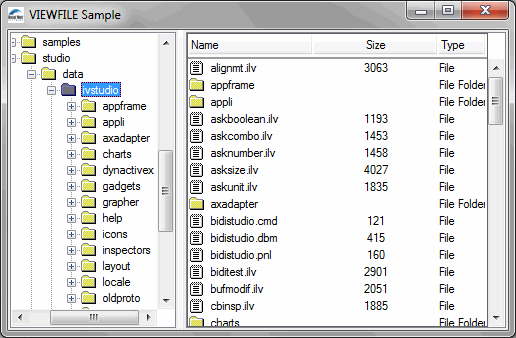Note: The classes IlPathName and IlString seen in the code for this step are used to make the code easier to read. |
FileViewer::FileViewer(IlvTreeGadget* tree, IlvSheet* sheet) : _tree(tree), _sheet(sheet) { // Initialize the gadgets. initObjects(); } |
void FileViewer::initTree() { // Set up the tree gadget. _tree->removeAllItems(IlvFalse); _tree->removeCallback(IlvTreeGadget::ExpandCallbackType(), TreeItemExpanded); _tree->addCallback(IlvTreeGadget::ExpandCallbackType(), TreeItemExpanded, this); _tree->removeCallback(IlvTreeGadget::SelectCallbackType(), TreeItemSelected); _tree->addCallback(IlvTreeGadget::SelectCallbackType(), TreeItemSelected, this); } |
Note: Each callback is removed prior to being added to avoid registering the same callback twice. |
void FileViewer::initSheet() { // Set up the sheet. _sheet->scrollBarShowAsNeeded(IlvTrue, IlvFalse); _sheet->hideScrollBar(IlvHorizontal, IlvFalse); _sheet->adjustLast(IlvTrue); _sheet->reinitialize(3, 1); _sheet->setNbFixedColumn(0); _sheet->scrollToColumn(0); _sheet->setExclusive(IlvTrue); _sheet->allowEdit(IlvFalse); // Create the header. _sheet->set(0, 0, new IlvLabelMatrixItem("Name")); _sheet->setItemAlignment(0, 0, IlvLeft); _sheet->setItemRelief(0, 0, IlvTrue); _sheet->setItemSensitive(0, 0, IlvFalse); _sheet->setItemGrayed(0, 0, IlvFalse); _sheet->set(1, 0, new IlvLabelMatrixItem("Size")); _sheet->setItemRelief(1, 0, IlvTrue); _sheet->setItemSensitive(1, 0, IlvFalse); _sheet->setItemGrayed(1, 0, IlvFalse); _sheet->set(2, 0, new IlvLabelMatrixItem("Type")); _sheet->setItemAlignment(2, 0, IlvLeft); _sheet->setItemRelief(2, 0, IlvTrue); _sheet->setItemSensitive(2, 0, IlvFalse); _sheet->setItemGrayed(2, 0, IlvFalse); } |
Note: The items making up the header are set to insensitive, meaning that the user will not be able to select them. |
void FileViewer::fillTree(IlvPathName& path, IlvTreeGadgetItem* parent) { // Read the 'path' directory and insert each sub-folder as a child of // the item 'parent'. if (path.openDir()) { IlvPathName file; while (path.readDir(file)) { if (file.isDirectory() && file.getDirectory(IlvFalse) != IlvString(".") && file.getDirectory(IlvFalse) != IlvString("..")) { IlvTreeGadgetItem* item = (IlvTreeGadgetItem*)createFileItem(file, _tree); item->setUnknownChildCount(IlvTrue); // Insert the directory 'file' into parent. parent->insertChild(item); // Compute the absolute path name. IlvPathName* absPathName=new IlvPathName(path); absPathName->merge(file); item->setclientData(absPathName) } } path.closeDir(); // Sort the added items. _tree->sort(parent, 1); } } |
Notes: 1. The member function setUnknownChildCount is called for each added item to ensure that the Expand callback is invoked. For more information, see “Changing the Characteristics of an Item” in Using Common Gadgets. 2. The client data of an item is used to store the path object that references the directory that the item points to. This object is a cache that avoids recomputing the absolute path of the item each time. |
static void TreeItemExpanded(IlvGraphic* g, IlvAny arg) { IlvTreeGadgetItem* item = ((IlvTreeGadget*)g)->getCallbackItem(); if (!item->hasChildren()) { FileViewer* viewer = (FileViewer*)arg; IlvPathName* path = (IlvPathName*)item->getClientData(); viewer->updateTree(*path, item); } } |
void FileViewer::updateTree(IlvPathName& path, IlvTreeGadgetItem* item) { _tree->initReDrawItems(); // Reset the tree, if needed. if (!item) initTree(); // Fill it using the 'path' directory. fillTree(path, item? item : _tree->getRoot()); // Finally, redraw. _tree->reDrawItems(); } |
static void TreeItemSelected(IlvGraphic* g, IlvAny arg) { // Retrieve the item that has triggered the callback. IlvTreeGadgetItem* item = ((IlvTreeGadget*)g)->getCallbackItem(); // In the case of a selection (this callback is also called when an item // is deselected) update the sheet. if (item->isSelected()) { // Retrieve the path of the item. IlvPathName* pathname = (IlvPathName*)item->getClientData(); // Retrieve the file viewer instance. FileViewer* viewer = (FileViewer*)arg; // Update the sheet. viewer->updateSheet(*pathname); } } |
void FileViewer::updateSheet(IlvPathName& path) { _sheet->initReDrawItems(); // Reset the sheet. initSheet(); // Read all the files contained in 'path'. if (path.openDir()) { IlvPathName file; while (path.readDir(file)) { if (!file.isDirectory() || (file.getDirectory(IlvFalse) != IlvString(".") && file.getDirectory(IlvFalse) != IlvString(".."))) { if (!file.isDirectory()) file.setDirectory(path); // Add the file to the sheet. addFile(file); } } path.closeDir(); } // Recompute the column sizes. _sheet->fitWidthToSize(); // Invalidate the whole sheet. _sheet->getHolder()->invalidateRegion(_sheet); // Finally, redraw. _sheet->reDrawItems(); } |
void FileViewer::addFile(const IlvPathName& file) { // Create the gadget item that will be inserted into the sheet. IlvGadgetItem* item = createFileItem(file, _sheet); // Encapsulate it with a matrix item. IlvAbstractMatrixItem* mitem = new IlvGadgetItemMatrixItem(item); // Add a new row in the matrix . _sheet->insertRow((IlvUShort) -1); IlvUShort row = (IlvUShort)(_sheet->rows() - 1); // Set the item in the first column. _sheet->set(0, row, mitem); _sheet->resizeRow((IlvUShort)(row + 1), item->getHeight() + 1); _sheet->setItemAlignment(0, row, _sheet->getItemAlignment(0, 0)); // File Size in the second column. _sheet->setItemSensitive(1, row, IlvFalse); _sheet->setItemGrayed(1, row, IlvFalse); _sheet->setItemAlignment(1, row, _sheet->getItemAlignment(1, 0)); ifstream ifile(file.getString(), IlvBinaryInputStreamMode); if (!(!ifile)) { ifile.seekg(0, ios::end); streampos length = ifile.tellg(); mitem = new IlvIntMatrixItem(length); _sheet->set(1, row, mitem); } // File Type in the third column. mitem = new IlvLabelMatrixItem(file.isDirectory() ? "File Folder" : "File"); _sheet->setItemSensitive(2, row, IlvFalse); _sheet->setItemGrayed(2, row, IlvFalse); _sheet->setItemAlignment(2, row, _sheet->getItemAlignment(2, 0)); _sheet->set(2, row, mitem); } |
Note: The file names in the first column of the sheet are created with the same method as the one used for building the tree. |
IlvGadgetItem* FileViewer::createFileItem(const IlvPathName& file, const IlvGadgetItemHolder* holder) const { // Compute the item label. IlvString filename = file.isDirectory() ? file.getString() : file.getBaseName(); // If file is a directory, remove the trailing '/'. if (file.isDirectory()) filename.remove(filename.getLength() - 1); return holder->createItem(filename, 0, getBitmap(file, IlvGadgetItem::BitmapSymbol()), getBitmap(file, IlvGadgetItem::SelectedBitmapSymbol())); } |
IlvGadgetItem* item = holder->createItem(filename); item->setBitmap(IlvGadgetItem::BitmapSymbol(), getBitmap(file, IlvGadgetItem::BitmapSymbol())); item->setBitmap(IlvGadgetItem::SelectedBitmapSymbol(), getBitmap(file, IlvGadgetItem::SelectedBitmapSymbol())); return item; |
IlvBitmap* FileViewer::getBitmap(const IlvPathName& file, const IlvSymbol* state) const { if (state == IlvGadgetItem::BitmapSymbol()) return getBitmap(file.isDirectory() ? folderBm : fileBm); else return getBitmap(file.isDirectory() ? sfolderBm : sfileBm); } |
void FileViewerApplication::makePanels() { // Initialize the main window. initMainWindow(); // Initialize the application. configureApplication(); // Show it. getMainWindow()->show(); } |
void FileViewerApplication::configureApplication() { FileViewer* viewer = createFileViewer(getMainWindow()); FileViewerApplication::SetFileViewer(getMainWindow(), viewer); viewer->init(IlvPathName("/")); } |
Note: Calling FileViewerApplication::SetFileViewer connects the main window to the viewer. You can retrieve the file viewer connected to a specific window with FileViewerApplication::GetFileViewer. |
FileViewer* FileViewerApplication::createFileViewer(FileViewerWindow* window) const { return new FileViewer(window->getDirectoryHierarchy(), window->getFileList()); } |
